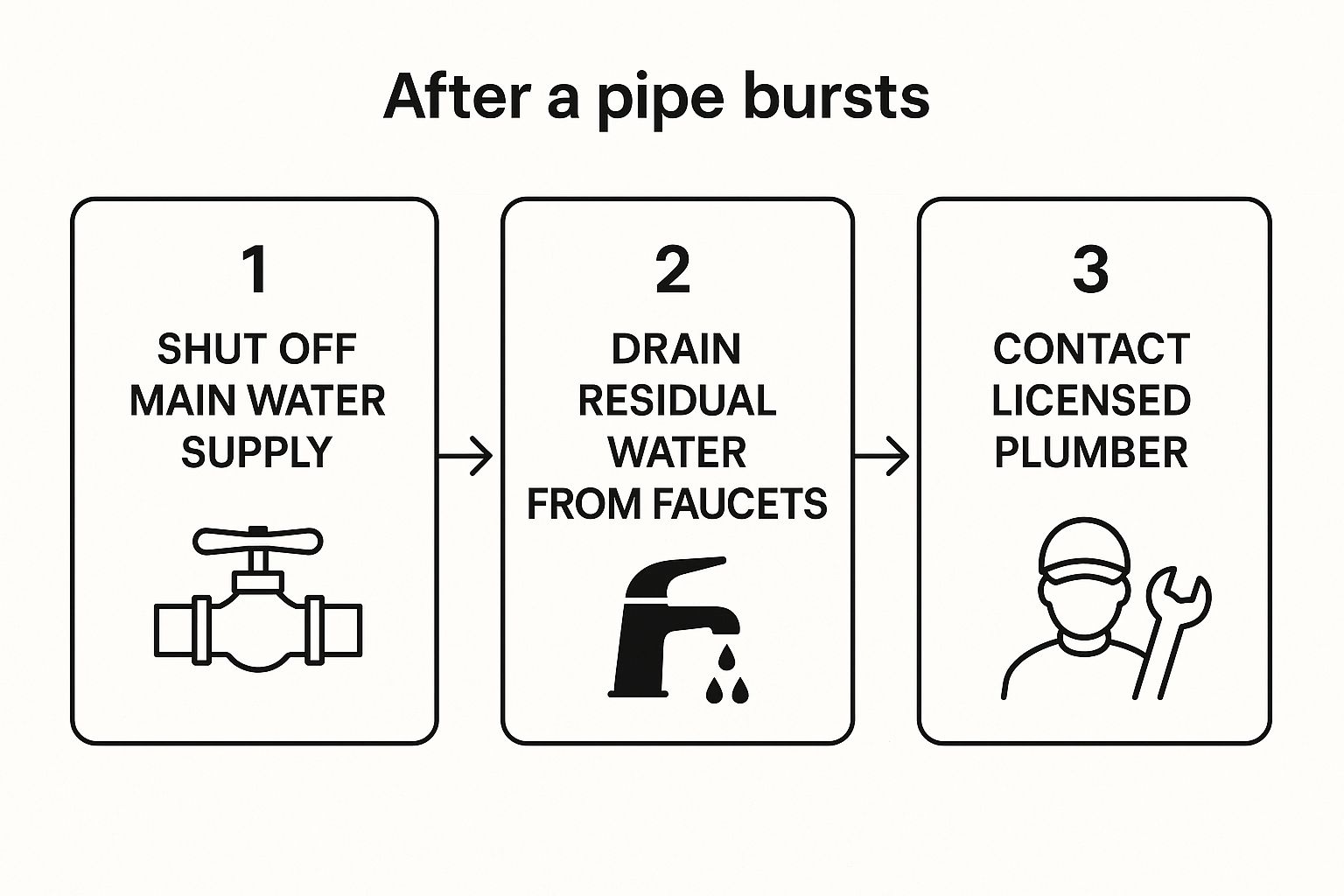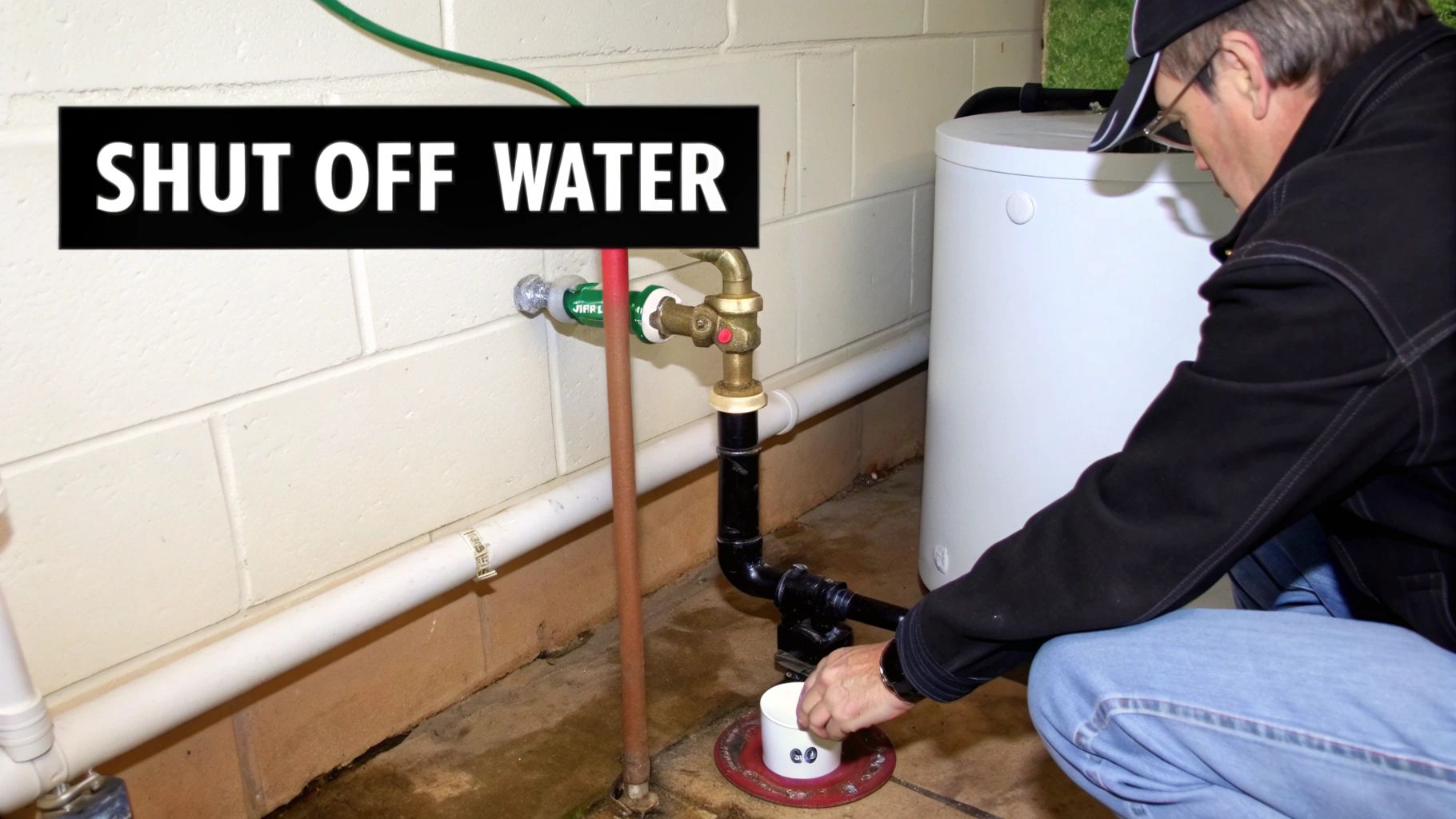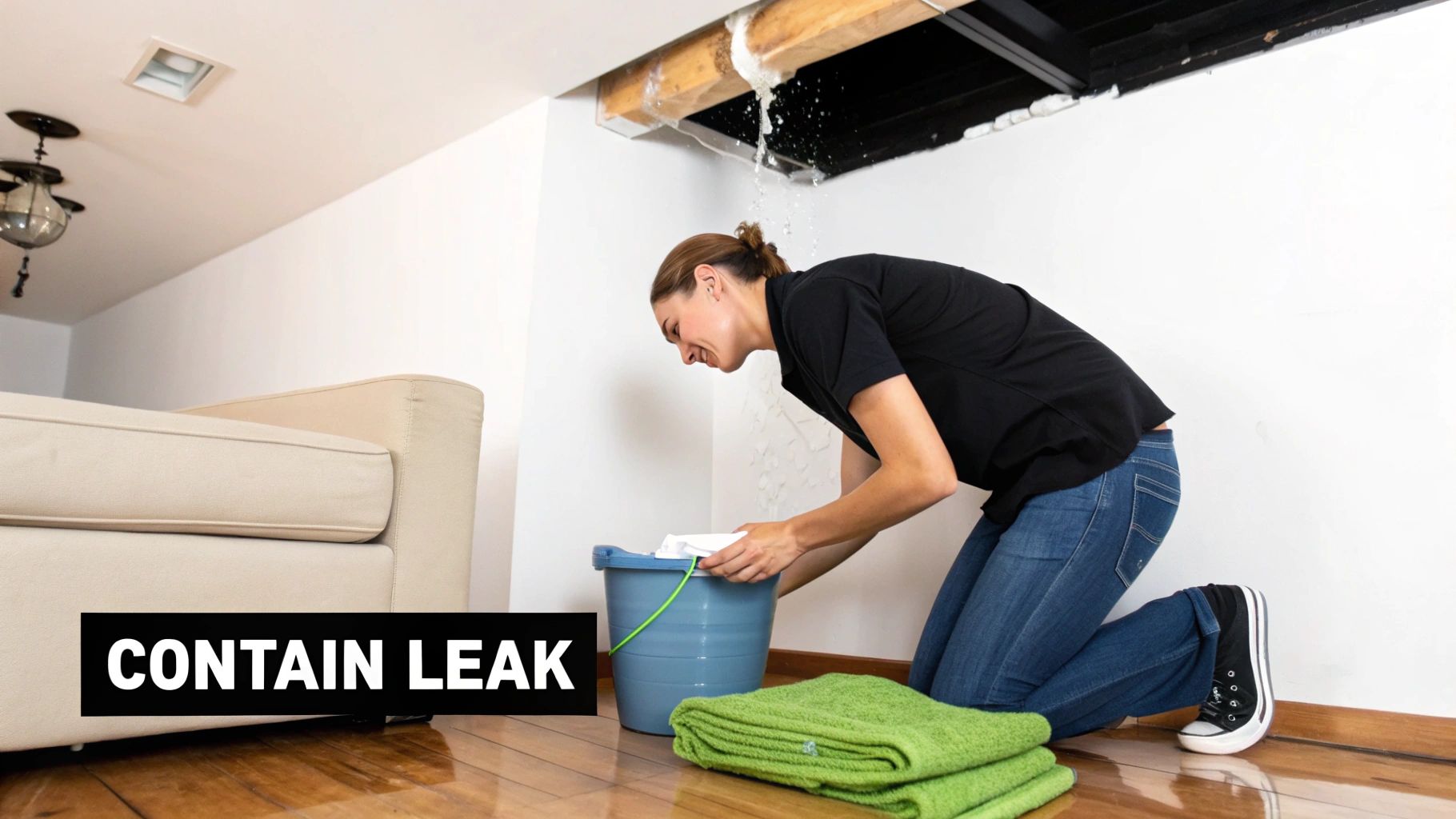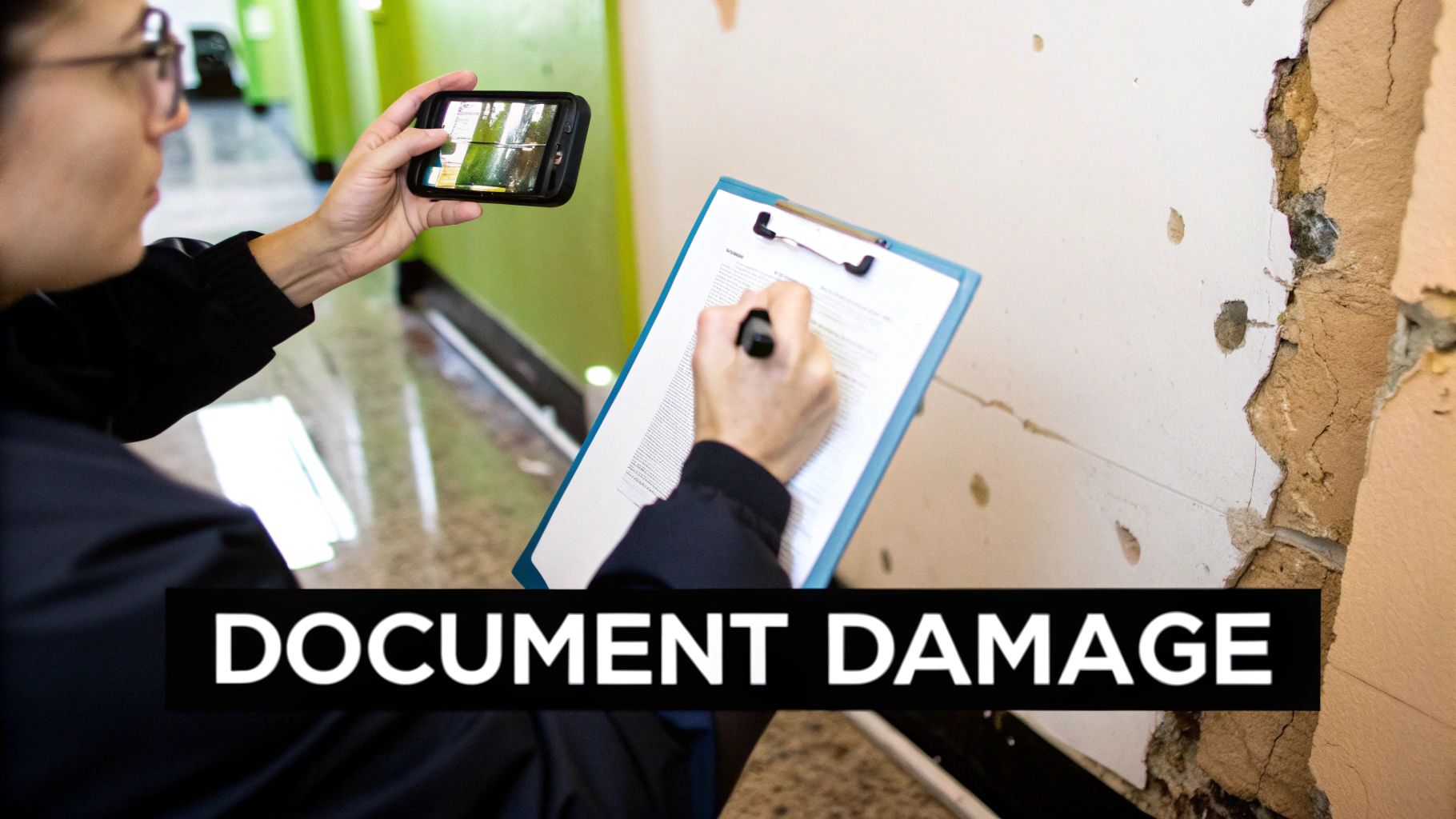What to Do If a Pipe Bursts in Your Eastbourne Home | Essential Tips
- Luke Yeates
- Oct 7
- 14 min read
That awful sound of rushing water is a homeowner’s worst nightmare. When a pipe lets go, panic can set in fast, but those first few moments are absolutely critical for damage control.
By taking a few calm, decisive steps, you can drastically reduce the damage to your Eastbourne property. Here at Harrlie Plumbing and Heating, we always tell our clients that what you do before we arrive is just as important as the repair itself.
Your First Five Minutes After a Pipe Bursts
The goal is to stop the flow, make the area safe, and get the remaining water out of the system. Let's walk through it.
Find and Shut Off the Main Water Supply
Your number one priority, before you do anything else, is to stop the water at its source. That means finding and turning off your main water stopcock.
In many Eastbourne homes, particularly the lovely older terraced houses in areas like Meads or Old Town, you'll typically find it under the kitchen sink. Other common spots include a downstairs loo, a utility cupboard, or sometimes in the garage. For a more detailed walkthrough, our guide on how to turn off your water main is an essential read for any homeowner.
Key Takeaway: Don't wait for an emergency to find your stopcock. Locate it now, make sure it's accessible, and test it once a year by turning it clockwise to ensure it isn’t seized. If it’s stuck, give Harrlie Plumbing and Heating a call to service it before disaster strikes.
Prioritise Electrical Safety
Water and electricity are a lethal combination. This isn't something to take lightly.
If the leak is significant or water is pooling anywhere near electrical outlets, sockets, or your fuse box, you must turn off your electricity immediately at the consumer unit (fuse box). This single action prevents the risk of electrocution and potential electrical fires. We've seen situations in properties near Hampden Park where a burst pipe upstairs quickly affects the ground floor electrics.
Even if the water seems far from electrics, it's a wise precaution. Water can travel surprisingly fast along ceiling joists and inside walls, appearing in places you'd least expect.
The infographic below shows the simple, methodical process for immediate damage control.

This visual flow reinforces that a calm response—stopping the source, draining the system, and then calling for help from a local plumber like Harrlie Plumbing and Heating—is the most effective way to manage the crisis.
Drain the System and Relieve Pressure
Once the water supply is off, there's still a surprising amount of water left in your plumbing system. To get this out safely, you need to drain it down.
Start by turning on all the cold taps in your home, beginning with those upstairs and working your way down. Don’t forget outside taps, showers, and bathtubs. Next, flush all your toilets multiple times until the cisterns are empty.
This helps to drain the remaining water, relieving the pressure that could cause even more damage at the site of the burst.
Immediate Action Checklist for a Burst Pipe
When you're in the middle of a plumbing crisis, it’s easy to forget a crucial step. This quick-reference table summarises what to do in those first critical minutes.
Action | Why It's Critical | Eastbourne Pro Tip |
|---|---|---|
Shut Off Main Water Supply | Immediately stops more water from flooding your property, preventing further structural and possession damage. | In many older Eastbourne properties, the stopcock can be stiff. Use a cloth for a better grip, but if it won't budge, call Harrlie Plumbing and Heating rather than forcing it. |
Turn Off Electricity | Prevents the life-threatening risk of electrocution and electrical fires if water reaches wiring or sockets. | Even if the leak is upstairs, water can run down inside walls to the ground floor electrics. Better to be safe and switch it all off. |
Open All Taps | Drains the remaining water from the pipes, relieving pressure and minimising further leakage from the burst. | Start with the taps highest up in the house (e.g., an upstairs bathroom) and work your way down to the lowest point. |
Call a Professional Plumber | Ensures a safe, correct, and lasting repair. A temporary fix might fail and cause more damage later. | Our number is 01323 400109. Save it in your phone now so you're not scrambling to find it during an emergency. |
Following these steps methodically can turn a potential catastrophe into a manageable problem, saving you thousands in potential repair costs while you wait for a Harrlie Plumbing and Heating engineer to arrive.
Why Pipes Burst in Eastbourne Homes

Understanding what causes a pipe to burst is the first real step toward preventing a disaster in your own home. In our experience across Eastbourne and Sussex, a few common culprits are responsible for the majority of emergency callouts we get at Harrlie Plumbing and Heating. It's rarely a single, dramatic event; more often, it's the result of pressure, age, or a simple accident finally reaching its breaking point.
From the picturesque cottages in the South Downs to modern homes near the Sovereign Harbour, no property is completely immune. However, knowing the risks means you can be proactive.
The Force of Freezing Temperatures
The number one cause of burst pipes, especially during a harsh UK winter, is freezing. It’s simple science. When water turns to ice, it expands by about 9%. This expansion exerts an immense, unstoppable pressure on the inside of a pipe—a force easily strong enough to split copper or plastic.
Pipes in unheated areas are always the most vulnerable. We frequently attend emergencies in Eastbourne where pipes in lofts, garages, or along exposed exterior walls have succumbed to the cold. A sudden cold snap after a mild spell often catches homeowners off guard, turning what was a simple pipe into a high-pressure water cannon.
The financial and practical impact of this can be huge. Last winter, burst pipe claims in the UK soared by a staggering 75%, partly because many households were avoiding using their heating due to high energy costs. This created a 'deep freeze' in December 2022, causing a massive spike in burst pipes as water expanded under pressure. The average repair cost jumped by around £4,000 in just one year. You can explore more data on how winter conditions affect UK homes on the Zurich UK media centre.
Corrosion and Ageing Pipework
Another major factor, particularly relevant here in coastal Eastbourne, is corrosion. Older properties, especially those with original galvanised iron or steel pipes, are highly susceptible to rust and degradation over the decades. The salty sea air we all know and love can unfortunately accelerate this process on any exposed pipework.
This corrosion doesn't just happen overnight. It's a slow, steady process that silently weakens the pipe walls from the inside out. Eventually, a section becomes so thin that it can no longer withstand normal water pressure, leading to a tiny pinhole leak or a complete, catastrophic rupture.
Harrlie Plumbing Pro Tip: If you notice discoloured water (brown or reddish) coming from your taps, or if your water pressure seems to have dropped over time, it could be a warning sign of internal corrosion. It’s well worth getting Harrlie Plumbing and Heating to do a professional inspection before a weakened pipe decides to fail completely.
High Water Pressure and Accidental Damage
Sometimes, the cause is less about the weather and more about the system itself. Persistently high water pressure puts constant strain on your entire plumbing system, including pipes, joints, and the connections to your appliances. While good pressure is great for a shower, excessive force will eventually find the weakest point in the network.
Finally, there’s simple human error. During a DIY project, it's surprisingly easy to accidentally drive a nail or screw into a pipe hidden behind a wall. We’ve seen it happen countless times in homes across Eastbourne. The initial damage might be small, causing a slow, hidden leak that only becomes apparent when a large damp patch appears on your wall or ceiling weeks later.
Containing Water and Limiting Damage
Right, you’ve managed to shut off the water and electricity. The initial heart-pounding panic is starting to fade. Now, your focus needs to pivot immediately to damage control. The name of the game is protecting your property and belongings from the water that’s already escaped, which will massively reduce the long-term impact while you wait for a professional plumber from Harrlie Plumbing and Heating.
Think of it as triage for your home. You need to identify and rescue the most valuable or vulnerable items first. This means grabbing electronics, crucial documents, and things you can't replace, like family photos. If it’s safe, get them moved to a completely dry part of the house. For bigger items like your sofa or cabinets, try hoisting them up onto wooden blocks or even sturdy plastic tubs to get their feet out of any standing water.
Managing the Immediate Mess
Even with the main water supply off, you’ve still got to deal with the water that’s already there. This is more than just a bit of mopping; it's about strategically managing the mess to stop it from spreading further or seeping deep into your floorboards and subflooring.
Here are a few practical tips our Harrlie Plumbing and Heating team often shares with clients across Eastbourne:
Create Barriers: Use old towels, blankets, or even rolled-up rugs to build small dams. This is surprisingly effective at containing the water to one area and stopping it from creeping into other rooms.
Use Buckets and Bins: Get buckets or any large, waterproof containers placed directly under drips to catch as much as you can. If you've got more of a stream, a simple dustpan can be a brilliant tool for directing the flow into a bucket.
The Bin Liner Trick: In a real pinch, a heavy-duty bin liner can be fashioned into a waterproof channel to guide water towards a bucket or, even better, an external door.
Actively managing the situation like this can make a huge difference in how much water your property absorbs. That’s absolutely critical for preventing mould and serious structural problems down the line.
Insurance Pro Tip: Before you start moving things or cleaning up too much, get your phone out and document everything. Take loads of photos and videos of the burst pipe itself, the path the water took, and all the affected areas and belongings. This evidence will be invaluable when you make your insurance claim.
Should You Attempt a Temporary Fix?
It’s tempting, I know, to have a go at a quick, temporary repair. You can buy things like pipe repair clamps or epoxy putty from most DIY shops, but we at Harrlie Plumbing and Heating urge extreme caution here. Trying to slap a clamp onto a high-pressure leak is much harder than it looks and can easily make the situation a whole lot worse if it’s not done perfectly.
A temporary fix is only ever a stopgap measure to slow a minor drip while you wait for an expert. It is never, ever a substitute for a proper, professional repair from a certified engineer.
In most cases, especially with a major burst, your time is far better spent on limiting the damage and taking photos for your insurance. Once you've got the immediate situation under control, you'll need to think about the aftermath. A comprehensive water damage restoration guide can be really helpful for understanding the next steps.
Honestly, your best and safest course of action is always to focus on containing the water and calling a qualified plumber like Harrlie Plumbing and Heating who can give you a permanent, guaranteed solution.
Knowing When to Call an Emergency Plumber

After you’ve managed to contain the immediate flood, the temptation to roll up your sleeves and attempt a DIY repair can be overwhelming. But let's be clear: a burst pipe is a huge red flag that the situation has gone far beyond a simple home fix. We're not just talking about stopping a leak here; this is about safeguarding the long-term integrity of your home’s entire plumbing system.
Trying a permanent repair yourself can open a Pandora's box of risks. An improperly sealed joint or a clamp that isn't quite right might seem to hold at first, but it’s often a ticking time bomb. Days or even weeks later, it could give way under normal water pressure, causing a second, potentially much worse, flood when you least expect it. At Harrlie Plumbing and Heating, we've seen this happen in Eastbourne homes, turning a single repair job into a much bigger one.
The Hidden Dangers of Improper Repairs
Even a "successful" DIY patch can create problems you can't see. A tiny, slow drip from a seal that isn't perfect can go unnoticed behind a wall or under your floorboards. This persistent dampness is the perfect breeding ground for mould, which can seriously compromise your home's air quality and lead to expensive structural damage down the line.
This is exactly where a professional makes all the difference. Qualified engineers don’t just put a plaster on the problem; they diagnose what caused it in the first place and implement a permanent, guaranteed solution.
The scale of this issue across the UK is staggering. Data shows that approximately 2,650 domestic pipes burst every year, causing nearly £50 million in damage. The problem hits its peak during the coldest months, with about 23% of all burst pipe insurance claims happening in January and February alone.
Calling a professional immediately is the single most important step you can take after shutting off the water. It stops a manageable emergency from spiralling into a long-term, expensive nightmare of water damage restoration, mould removal, and complex repairs.
What to Expect When You Call Harrlie Plumbing & Heating
When you ring our 24/7 emergency line here in Eastbourne, you’re not just calling a plumber—you’re setting in motion a rapid response process designed to get your home and life back to normal.
First, our team will assess the situation with you over the phone, asking key questions to get a handle on the severity and location of the burst. This lets us give you immediate safety advice and prepare our on-call engineer for what they’ll find when they arrive. We then dispatch a qualified professional straight to your Eastbourne home, aiming to get there as quickly as humanly possible.
Once on-site, our engineer will carry out a thorough inspection to pinpoint the exact point of failure and check for any collateral damage. They’ll explain the necessary repairs clearly, providing an upfront, transparent quote before any work starts. This commitment to honesty means you know exactly what to expect, with no hidden surprises.
Our goal is simple: to provide a safe, permanent, and guaranteed solution that secures your home. If you're ever in doubt, understanding when you need an emergency plumber in Eastbourne can help you make the right call, fast.
Proactive Steps to Prevent Future Pipe Bursts

The best way to deal with the stress and mess of a burst pipe is to make sure it never happens again. Moving from a reactive panic to a preventative mindset can save you an immense amount of hassle and expense down the line. A few straightforward maintenance steps are all it takes to fortify your home against future plumbing emergencies.
Many Eastbourne homes have vulnerable spots that are easy to overlook until it's too late. Unheated areas like lofts, garages, and basements are prime locations for pipes to freeze and fail during a cold snap. Your first and most effective line of defence is simple pipe insulation.
You can pick up foam lagging tubes at any local DIY shop. They're inexpensive, easy to install, and simply wrap around your pipes. Make sure to prioritise any pipework running along an external wall or that's exposed to the elements.
Smart Heating and Winter Preparedness
One of the most powerful tools you have against frozen pipes is your central heating. We know it’s tempting to switch it off completely to save on energy bills when you're away, but this can be a false economy.
During a cold spell, it’s far smarter to keep your heating on a low, constant setting—around 12-15°C is perfect. This keeps a gentle background warmth circulating through your home, ensuring the water in your pipes stays just above freezing. A small, consistent heating cost is infinitely better than the bill for repairing burst pipe damage—a scenario our Harrlie Plumbing and Heating engineers see all too often in Eastbourne winters.
For a deeper dive into protecting your system, check out our dedicated guide on how to prevent frozen pipes with essential tips for Eastbourne.
If you’re planning to be away for an extended period during winter, you might consider draining the system entirely. This involves shutting off your main stopcock and then opening all the taps to let the water run out. It's a foolproof way to ensure there’s no water left inside to freeze.
The Value of a Professional Plumbing Health Check
While DIY prevention is crucial, some problems are invisible to the untrained eye. Things like internal corrosion, hidden stress on joints, and minor pressure irregularities can build up for years without any obvious signs. This is where a professional plumbing health check from a trusted local company like Harrlie Plumbing and Heating becomes invaluable.
Think of it like an MOT for your plumbing. Our engineers can spot the subtle signs of wear and tear that often precede a catastrophic failure, allowing you to address them before they escalate into an emergency callout.
This proactive approach is especially important when you consider the UK's wider water infrastructure. In England and Wales, water companies carry out over 44,000 pipe repairs every year—that’s more than 100 bursts fixed every single day. The data shows a significant spike in failures during colder months, particularly in Southeast England, highlighting just how vulnerable our region’s plumbing is to the climate.
A regular inspection is a small investment that offers massive peace of mind, ensuring your home's plumbing is robust enough to handle whatever the Eastbourne weather decides to throw at it.
Your Questions About Burst Pipes Answered
When a pipe lets go, it’s completely overwhelming. The mind races, and questions start popping up thick and fast. Here at Harrlie Plumbing and Heating, we’ve heard just about every question from concerned Eastbourne homeowners over the years. We've put together some clear, straightforward answers to the most common queries we get, hoping to help you feel a bit more in control when things get stressful.
How Do I Find My Main Water Stopcock?
Knowing where your main water stopcock is located is absolutely crucial in any plumbing emergency—it’s the first thing you need to find. Most of the time, you'll find it tucked away under the kitchen sink.
However, in many Eastbourne properties, it could just as easily be in a downstairs toilet, a utility room, or even the garage. Look for a small, tap-like valve on the pipework coming into your home. Our best piece of advice? Find it and test it before you ever have an emergency. A gentle quarter-turn clockwise should shut off the water completely. If it feels stiff, don't try to force it with a wrench. That can do more harm than good. Just give Harrlie Plumbing and Heating a call, and we can come and service it for you.
Is Water Damage from a Burst Pipe Covered by Insurance?
This is often the first thing people worry about once the initial shock wears off. Generally speaking, most standard home insurance policies do cover the resulting water damage, which they often refer to as 'escape of water'.
What you need to be aware of, though, is that the policy might not cover the cost of repairing the actual burst pipe itself. It’s always best to dig out your policy documents and check the specific wording.
For a detailed look at the specifics, it's worth understanding whether homeowners insurance covers burst pipes. Pro tip: always take plenty of clear photos and videos of the damage to support your claim.
What Is the Typical Cost to Repair a Burst Pipe in Eastbourne?
Honestly, the cost can vary quite a bit. It really depends on a few key factors: the pipe's location, how easy it is for us to get to, and the extent of the damage.
A simple, straightforward repair on an exposed copper pipe in a garage in Langney might only be a few hundred pounds. But if our engineers need to lift floorboards in a classic Victorian terrace in Old Town or cut into a newly tiled bathroom wall to access hidden pipes, the cost will naturally be higher because of the extra labour involved. At Harrlie Plumbing and Heating, we believe in total transparency. We’ll always provide a clear, upfront quote before we start any work, so you know exactly what to expect with no surprises.
Can I Turn My Water Back on After a Temporary Fix?
We strongly, strongly advise against this. Temporary pipe clamps or those emergency repair tapes you can buy are only designed to slow or stop the flow of water while you wait for a professional to arrive. They are absolutely not a permanent solution.
Turning the main water supply back on puts the pipework back under full pressure, which can easily cause the temporary patch to fail. If that happens, you could be dealing with another flood, and it might be even worse than the first one. It’s always safest to keep the water off until one of our qualified engineers has completed a permanent, guaranteed repair.
Facing a burst pipe is a homeowner's nightmare, but you don't have to handle it alone. For a fast, reliable, and professional solution in the Eastbourne area, trust the experts at Harrlie Plumbing and Heating. Visit us at https://www.harrlieplumbing.co.uk or call our emergency line for immediate assistance.

Comments